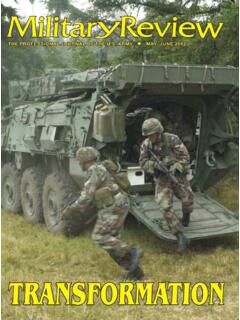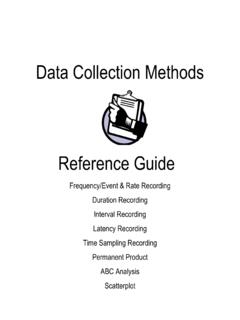Transcription of Marine Corps Support to Joint Operations in Contested ...
1 Preparing for the Future Marine Corps Support to Joint Operations in Contested Littorals Gen. david H. Berger, Marine Corps O ver the last five years, the defense establish- ment has begun to grapple with the implications of the advent of a radically more complex and challenging strategic epoch. The return of great-power competition and the critical future scenarios may revolve around enabling naval and Joint force commanders as a dedicated multi-domain reconnaissance and counterreconnaissance force. Reconnaissance and counterreconnais- sance are precisely defined in Joint and continuing threats of regional rogue service doctrine. Reconnaissance states and violent nonstate actors Operations , in any domain, use challenge our Nation's interests the full range of available amid an ongoing revolution detection methods to ob- in technology that poses both tain information about the peril and promise.
2 1 activities and resources of Consideration of the an enemy or adversary. 2. challenging future these Counterreconnaissance changes are likely to produce seeks to prevent adversaries has sparked an energetic focus from doing the same to us; it on developing new operat- comprises all measures taken ing concepts, technologies, and to prevent hostile observation of a force structures in all the military force, area, or place. 3 In the maritime services. The Marine Corps is no context, it is wise to marry these current exception. In close partnership with the doctrinal definitions with the broader per- Navy, our thought in recent years has converged spective conveyed in two navy words of distinguished around the concepts of littoral Operations in Contested lineage : scouting and screening. The distinguished naval environments and expeditionary advanced base Operations , tactician Capt.
3 Wayne P. Hughes Jr. defined scouting and their implications for the full range of Title 10 as reconnaissance, surveillance, code-breaking, and all service functions in organizing, training, and equip- other ways to obtain and report combat information ping the forces necessary to execute them. During my to commanders and their forces, and screening as all predecessor's tenure as commandant, the Marine measures used to frustrate the enemy's scouting effort Corps embarked upon a campaign of learning to draw includ[ing] the possibility of attacking a threatening out these implications, a campaign that has continued enemy. 4 This broader naval understanding of the mis- and accelerated on my watch. Our learning to this sion informs my understanding of reconnaissance and point has led us to some interesting initial conclusions counterreconnaissance in the pages that follow.
4 And hypotheses. One of the most interesting is the The most recent phase of the Marine Corps '. possibility that a major role for Marine Corps forces in learning process began with my Commandant's Planning MILITARY REVIEW ONLINE EXCLUSIVE APRIL 2021. 1. Marine Corps . Guidance of July 2019, amplified by a June 2020 article to meet the demands of this rapidly changing operat- articulating The Case for Change, in which I laid out ing environment, I have been deeply engaged over the my assessment of the major features of the operating last eighteen months with the challenge of formulating environment for which we now have to Nesting appropriate responses to those within the 2018 National Defense Strategy's threat A major part of the Marine Corps ' response to this analysis, I observed that military responses to the challenge is the program of development and learning that we call Force Design 2030 (FD 2030).
5 We have already executed some of the less controversial elements of this program for example, my decision to divest the entire Marine Corps inventory of M1A1 Abrams tanks. The more consequential elements of the program are still underway, and among these are significant changes to a major portion of our ground combat element: fielding the Marine Littoral Regiment, restructuring our infantry battalions, and eliminating much of our existing towed cannon artillery in favor of longer-range rocket and mis- sile systems. The latter will be able to launch a wide range of containerized munitions, including antiship missiles. Accompanying these changes are shifts in supporting aviation and logistical capabilities. The overall thrust of our FD 2030 program is to produce a Marine Corps that is prepared to operate inside actively Contested maritime spaces in Support of fleet Operations that are themselves nested within overarching Joint These initial changes are the early stages of a much longer campaign.
6 They will allow us to free resources and field experimental capabilities for the sustained period of innovation that the operating environment demands. As FD 2030 is at its heart To view the Commandant's Planning Guidance: 38th Commandant a campaign of learning, it Gen. david H. Berger is of the Marine Corps , visit is not surprising that after the thirty-eighth comman- Docs/%2038th%20 Commandant%27s%20 Planning%20 Guid- a bit more than a year of dant of the Marine work, we have learned Corps . He has commanded some things. The wargam- at every level, including ing and experimentation during deployments to Haiti, challenges posed by revisionist powers, rogue states, and we have done thus far, Iraq, and Afghanistan. He is a technologically advanced nonstate actors must contend culminating in the annual graduate of the Marine with the realities of an increasingly mature precision Naval Services Wargame Corps Command and Staff strike regime.
7 Several of these actors also make use of in October 2020, suggests College and the Marine a sophisticated toolkit of coercive behaviors below the that the basic proposition Corps School of Advanced threshold of violence that some describe as gray-zone of FD 2030 remains valid. Warfighting, and he holds strategies. I also noted the obvious facts of geography Given the realities of geog- multiple advanced degrees the intersection of threat and interests means that raphy and the proliferating including a master of inter- our interaction with several of our most formidable chal- precision strike regime, the national public policy from lengers will largely occur within the maritime domain. Navy and the Joint force Johns Hopkins University Sharing my predecessor's conclusion that the Marine will need an inside or School of Advanced Corps is not organized, trained, equipped, or postured stand-in force that can International Studies.
8 MILITARY REVIEW ONLINE EXCLUSIVE APRIL 2021. 2. Marine Corps . operate persistently within the weapons engagement need most from the Marine Corps . The answer to the zone (WEZ) of a peer adversary. Such a capability is question of how we may best Support the broader ef- particularly critical in the contact and blunt layers fort, it seems increasingly likely, is not lethal fires as an of the Global Operating Model , when Joint forces end in themselves but rather reconnaissance and coun- must compete below the level of armed conflict terreconnaissance applied in all domains and across the and should that competition escalate to armed conflict, competition Given the realities of geography and the proliferating precision strike regime, the Navy and the Joint force will need an inside' or stand-in' force that can oper- ate persistently within the weapons engagement zone (WEZ) of a peer adversary.
9 Delay, degrade, or deny adversary aggression. 8 Stand-in The logic of this requirement is clear. With the forces will be constantly present in key maritime terrain proliferation of the precision-strike regime, the ability during periods of competition below the threshold of of the naval and Joint force to retain the initiative violence, deterring and countering nonlethal coercive and ultimately to conduct effective offensive action behavior and other malign activity directed at allies, to reverse adversary aggression will depend critically partners, and other interests. These same forces will re- on the ability to win the hider-finder competition. main inside an adversary WEZ to provide necessary sup- Given the rapidly advancing capabilities of our pacing port to naval and Joint campaigning should competition threat, the People's Republic of China (PRC), the escalate to war.
10 Critically, given the vulnerability of large, Joint force's historically dominant capability to sense fixed bases and shore-based infrastructure to long-range and understand its operating environment will be precision strike and the challenges of adequately defend- vigorously Contested or denied in every domain. At ing that infrastructure, the stand-in force must be able least initially, as wargame after wargame suggests, to perform these functions from a strictly expeditionary fixed land bases and high-signature land forces will and highly mobile posture. be vulnerable to long-range precision weapons. Large These broad conclusions are well supported by the naval vessels will likewise initially face considerable wargaming and analysis we have done thus far. Our risk operating within the range of a peer adversary's ongoing learning from these tools as well as from exper- long-range precision strike capabilities, including DF- imentation and large-scale exercises is steadily gener- 21 and DF-26 antiship ballistic Given our ating answers to the question of how the Marine Corps pacing threat's capabilities in the space and infor- can most usefully contribute to solving naval and Joint mation domains, reliable tracking and cuing of naval force commanders' problems as a stand-in force.













